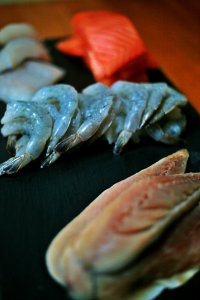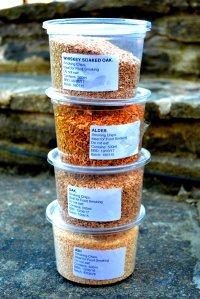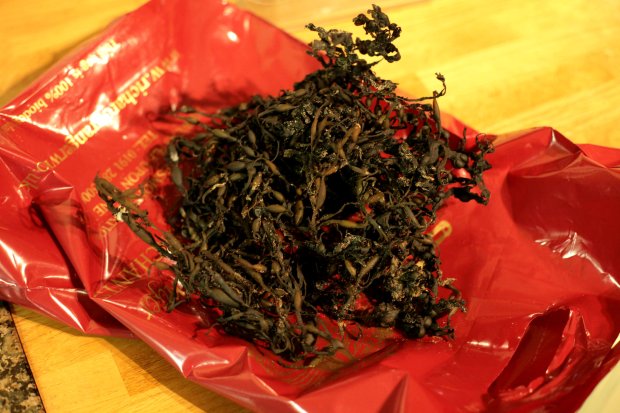Smoking is an age-old art and yet a prevalent part of the modern menu. Whether it’s the humble kipper, crisp smokey bacon or one of the myriad Michelin-smoked elements scattered throughout London’s finest eateries, smoked food has never been more popular. And yet few of us bother doing it at home.
 Now perhaps you thought that smoking fish would be a rather fruitless rigmarole, best left to the rugged smokehouses of the East coast and the generations of experience therein, but in fact hot-smoking is a fairly faff-less and fuss-free affair- and rather fun to boot! First you’ll need a smoker: this needn’t be a commercially produced number with an off-putting price tag, a simple casserole dish with a punctured foil shelf and a tight fitting lid will do. Fortuitously, Matt stumbled across a bargainous portable smoker in the local cash converters, so we used that.
Now perhaps you thought that smoking fish would be a rather fruitless rigmarole, best left to the rugged smokehouses of the East coast and the generations of experience therein, but in fact hot-smoking is a fairly faff-less and fuss-free affair- and rather fun to boot! First you’ll need a smoker: this needn’t be a commercially produced number with an off-putting price tag, a simple casserole dish with a punctured foil shelf and a tight fitting lid will do. Fortuitously, Matt stumbled across a bargainous portable smoker in the local cash converters, so we used that.
Four Types of Fish
 Before the smoldering can start, you need to salt your fish. As this is a taste test, we chose four different types of fish or shellfish: salmon, mackerel (both perennial smoked favourites), haddock ( usually found cold-smoked and stained yellow) and prawns (which I’d never tried smoked before, so all the more reason to give them a go). Salting is an essential part of the process; it traditionally helped to preserve the fish, but also helps those smoky flavours penetrate the meat. Wisdom seems divided over exactly how long and how much salt a good brining takes, but we simply covered our fish with a dry salt rub (half an hour for the prawns and mackerel, an hour or so for the chunkier haddock and salmon), rinsed the salt off and let the fish dry until a tacky pellicle formed.
Before the smoldering can start, you need to salt your fish. As this is a taste test, we chose four different types of fish or shellfish: salmon, mackerel (both perennial smoked favourites), haddock ( usually found cold-smoked and stained yellow) and prawns (which I’d never tried smoked before, so all the more reason to give them a go). Salting is an essential part of the process; it traditionally helped to preserve the fish, but also helps those smoky flavours penetrate the meat. Wisdom seems divided over exactly how long and how much salt a good brining takes, but we simply covered our fish with a dry salt rub (half an hour for the prawns and mackerel, an hour or so for the chunkier haddock and salmon), rinsed the salt off and let the fish dry until a tacky pellicle formed.
Four Types of Wood
 Basically, to smoke anything, throw some wood chips in the bottom of your smoking contraption, place the food on a trivet of some sort, cover tightly and heat up the wood so it starts to generate a healthy dose of smoke- we found fifteen-twenty minutes was more than enough, but it probably differs from smoker to smoker. For our taste test we had four woods: Alder, which seems to be a popular choice across Europe and America where it’s the most common wood for smoking salmon; Ash, whose flavour had only been described to us as distinctive; Oak, another popular wood and probably the most common for smoking salmon in Britain; and whisky-soaked Oak, there was only one way to find out if a drop of scotch makes any difference. Finally, we’d heard that seaweed could be used, and given it’s free and practical, Matt foraged a little on his way over.
Basically, to smoke anything, throw some wood chips in the bottom of your smoking contraption, place the food on a trivet of some sort, cover tightly and heat up the wood so it starts to generate a healthy dose of smoke- we found fifteen-twenty minutes was more than enough, but it probably differs from smoker to smoker. For our taste test we had four woods: Alder, which seems to be a popular choice across Europe and America where it’s the most common wood for smoking salmon; Ash, whose flavour had only been described to us as distinctive; Oak, another popular wood and probably the most common for smoking salmon in Britain; and whisky-soaked Oak, there was only one way to find out if a drop of scotch makes any difference. Finally, we’d heard that seaweed could be used, and given it’s free and practical, Matt foraged a little on his way over.
Taste Test
1. Alder- There’s good reason why this wood is such a go-to in the smoking stakes: it ‘s sweet, mild and verging on fruity, lending the fish a rather reddish colour. All in all, we gave it an 8.5/10.
salmon: A fine combination; all of us on the tasting panel thought it had a good flavour.
mackerel: Again, the flavours worked. If anything, it was perhaps too mild for the mackerel.
prawn: The first smoked prawn any of us had tried was a good one. The alder smoke helps bring out the natural sweetness of the prawn.
haddock: Matt enjoyed it, but we all thought it was the least successful of the alder smokings- for me the flavour was a little too woody, like taking a bite out of Homebase.
2. Ash- Well it certainly is distinctive, but not beyond description: it was somewhat citrussy and kinda piney with a much paler colour than the alder. Altogether, we found ash to be a little unpleasant; it’s resin-like flavour might partner well with something, but we didn’t think it worked with any of our four fish, hence we gave it a 4/10.
salmon: It wasn’t terrible, but not as nice as the alder.
mackerel: The mackerel could just about stand up to the flavour.
prawn: Not the worst, but the ash didn’t improve the prawn.
haddock: Only one of our tasting panel liked ash-smoked haddock, but I’m quite certain it’s an acquired taste.
3. Oak- It may be traditional, but it was rather strong and not very sweet at all. No fish tasted bad with the oak, but it might benefit from being mixed with another, more neutral wood, like beech. We thought it merited a 6/10.
salmon: No complaints; most of the panel thought this worked just fine
mackerel: A good pairing; the flavours seemed to compliment each other.
prawn: Not bad- Matt thought it was the best of the round.
haddock: Perhaps haddock is the issue as nothing yet seems to’ve worked particularly well with it.
4. Whisky-soaked Oak- This was similar to the oak, but much sweeter and therefore a fair bit nicer. Like it’s teetotal counterpart, it stained the fish a rather rich brown and left quite a strong flavour. We much preferred the boozier oak and gave it a 7.5/10 overall.
salmon: I really enjoyed this match, but one of the panel thought it reminiscent of plastic bags.
mackerel: Two of our panel considered this to be the best wood smoke for mackerel and I may very well be inclined to agree.
prawn: Perfectly nice.
haddock: Better than with the unsoaked oak, one of our panel thought it might be the haddock’s best team-up.
5. Seaweed- Finally, the foraged seaweed of which we had high hopes: it produced a strong-smelling aroma a little like burnt paper and, indeed, there was an undertone to that in the flavour. The taste was primarily salty with a hint of petrol and this was equally as disappointing with each of our fish. Not revolting, but not good either, so we gave it a 5/10.


Thanks so much for this useful information! I came across your post whilst searching for an appropriate smoking wood for some Spanish mackerel. After reading about your results, I opted for the whiskey-smoked oak (that’s whiskey with an e, as in Bourbon) and threw a handful of cherrywood into the mix. The results were sweet and full-bodied, with a pleasant red tinge. Completely delicious – thanks again!
LikeLiked by 1 person
Sounds delicious. So pleased you found the post useful!
LikeLike